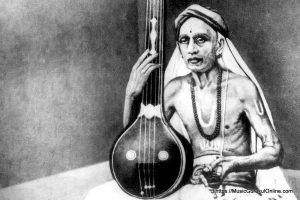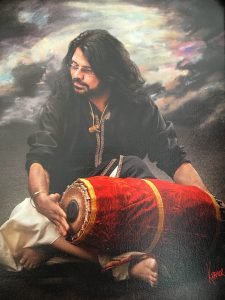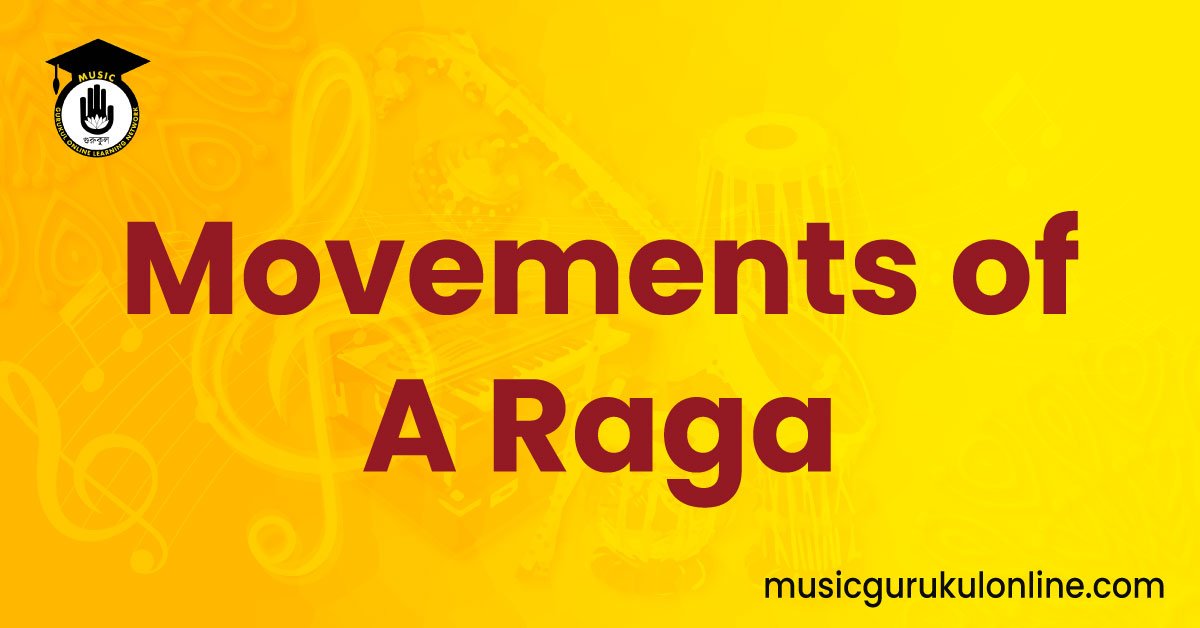Movements of a Raga : When a scale is given an Arohana, Avarohana along with Gamakas, and other pleasing ornamental effects, a complete Raga is born. Listening is the journey of exploring that establishment.

A Raga is defined as:
स्वरवर्णविशेषेण ध्वनिभेदेन वा पुनः ।
रज्यते येन यः कश्चित् स रागः सम्मतः सताम् ॥
“A group of Swaras are said to be a Raga only when they are pleasing due to their distinguishing tonal colours and modulations.”
How does a Raga move? It moves both in the Kalpana or extempore aspects and in the Kalpita or preset compositional aspects of music.
Table of Contents
Anibaddha Sangitam – anibaddha sangitam- अनिबद्ध संगीतम्
When the music moves without a fixed rhythm, it is said to be Anibaddha or ‘unbound’. The major portion of the extempore music is Anibaddha.
Nibaddha Sangitam nibaddha sangitam – निबद्ध संगीतम्
Nibaddha means ‘closed’ or ‘bound’. When a rhythm is intro duced in the music, with or without a Tala, it is called Nibaddha Sangita. Mostly the preset compositions fall under this category.
Kalpita Sangitam – kalpita sangitam-flag
Kalpita means ‘taught’. The major portion of this music is Nibaddha. Carnatic music has always consisted of both extempore creative music and preset or composed music. In the earlier times, the extempore style predominated. But in the present century, specially after the music moved away from the royal courts and elite listeners and came to the common people, the preset compositions have come to play a dominant role. These are ready capsules of Raga movement which are taught and practised well before presentation. The Kalpita Sangita group has got several compositional types. These compositions have definite sections of musical movement.

Pallavi-pallavi – पल्लवि :
Pallavi is the opening section of a composition like Kriti, Padam etc. The Graha Swara or the opening note of the Pallavi is the Vadi of the composition which is an Amsa Swara. The starting point of the Pallavi on the Tala is called the Tala Graha. Pallavis are generally short.
Listen to : P. Unnikrishnan – Vocal – Raga Latangi
Anupallavi – anupallavi:
Anupallavi is the second section of a composition which follows the Pallavi. It takes the Ragasanchara or the movement of the Raga into the higher ranges. The Grahaswaras of the Anupallavi generally have the Samvadabhava, to those of the Pallavi.
Listen to : P. Unnikrishnan – Vocal – Raga Latangi
Charanam – caraṇam:
Charanam is the concluding section of a composition. It is the third section and normally consists of four lines. The musical movement on the first two lines is different from that of the Pallavi and the Anupallavi. The second two lines are generally a replica of the music of the Anupallavi.
Listen to : P. Unnikrishnan – Vocal – Raga Latangi
Samasti Charanam samasti caranam- समस्ति चरणम् :
Samasti means ‘aggregate’. Sometimes the Anupallavi is omitted and instead a short Charanam, consisting of two lines, called Samasti Charanam is sung. The concluding por tion of a Samasti Charanam is invariably a Madhyamakala Sahityam.
Listen to : P. Unnikrishnan – Vocal – Raga Nattai
Other Appendages :
The other appendages like Swara Sahityam, Chittaswaram etc., which are already explained add beauty to the musical movement.

Kalpana or Manodharma Sangitam – kalpanā – manodharma sangitam – कल्पना मनोधर्म संगीतम् :
Kalpana means ‘imagination’. In Kalpana or Manodharma Sangitam, the music moves freely according to the extempore and creative ability of the musician. This branch also has its various forms. Mostly Manodharma Sangitam is Anibaddha or unbound.
Alapana – ālāpana:
Alapah means ‘narration’. Ragalapana is the entire elaboration of the Raga, presenting its various features and moods. It is Anibaddha, that is to say without any fixed rhythm. The Alapana is sung mostly with Akaram, interspersed with sylla bles like Ta, Da, Ri or Nam. It has definite sections.
Aksiptika – akshiptika :
In ancient Indian theatre, Aksiptika was a song by an actor as he approached the stage. In a Ragalapana, Aksiptika forms the prelude to the detailed Alapana. It is the introduction to the Raga under elaboration. Aksiptika is peformed in a mixture of speeds. It is also called Ayattam.
Listen to : P. Unnikrishnan – Vocal – Raga Karaharapriya
Aksiptika is a must in a Ragam-Tanam-Pallavi but it is optional in a Raga preceding a Kriti.
Ragavardhani – ragavardhani-
Vardhana means ‘to expand’. Ragavardhani is also mentioned as Karanam in the traditional texts. It is the elaboration of the Raga. This forms the major part of Ragalapana. It follows the Aksiptika. It is divided into several sections called Vidari. Niyasalankara, Rakti Prayogas are interspersed in the expan sion of Ragavardhani. Music in Ragavardhani moves in a mix ture of speeds.
The elaboration of the Raga goes in Vidaris or sections, each Vidari having its own Graha Swara which is an Amsa. In the example given here, we have first an Aksiptika and the musician commences the first Vidari of Ragavardhani on it.
This Vidari commences on the note Ri. The musician sustains this note as a Dirgha Swara. The Sancharas are mainly below Ri. This section ends on the note Sa which is also an Amsa.
The next Vidari or section commences on Pa and contains Rakti Prayogas.
Then the musician moves to the next Graha Swara, Dha, thereby commencing the next Vidari. On reaching Shadja he builds the last Vidari. He takes up Tara Sthayee Sancharas mainly in this section.
All along, the music moves in a mixture of speeds, inter spersed with Rakti Prayogas, Varnalankaras and Niyasa.
Listen to : P. Unnikrishnan – Vocal – Raga Karaharapriya

Taanam-tanam:
Taanam as a form of Raga Sanchara, forms the second part of the extempore music. The middle tempo is the chara cteristic feature of this form and hence it is called Madhyamakalam. Taanam in Duritakala or fast tempo is call Ghanam. Taanam is sung using the syllables, Nom, Anantam etc.
Listen to : P. Unnikrishnan – Vocal – Raga Sankarabharanam
Taanams are of many varieties which have specific names, Gaja Taanam, Asva Taanam, Markata Taanam, Manduka Taanam, Chakra Taanam, Vakra Taanam etc.
Pallavi-pallavi:
Pallavi also means the third section of the movement of a Raga in the Ragam-Tanam-Pallavi rendition. Pallavi is interpreted as Pa for Pada, La for Laya and Vi for Vinyasa, which means words, rhythm and assembling them in various ways. Pallavi is a short lyrical composition wherein the lyric plays a secondary role. The music and rhythm predominate. The lyric of a Pallavi is precomposed or improvised on the spot. It is a highly devel oped art form which provides great scope for a musician’s mastery and creativity.
Alapana is totally Anibaddha, that is without a rhythm, Tanam has an undercurrent of Laya or rhythm, but is not bound by a Tala as such. Pallavi introduces a Tala, a rhythmic metre. Normally Pallavis are set to complex Talas, preferably in slow pace allowing scope for acceleration of speeds.
The basic structure of the is called the Aus which is formed of Purvanga, Arudi and Uttaranga.
Listen to : P. Unnikrishnan – Vocal – Raga Sankarabharanam
Purvanga – purvānga :
The Pallavi consists of two sections and the first division is called the Purvanga. This is longer than the second section an ends on the beat after the first Laghu of the Tala, which is called Arudi.
Listen to : P. Unnikrishnan – Vocal – Purvanga
Uttaranga – uttaranga – उत्तरांग :
Uttaranga is the second part of the Pallavi. This is shorter than the Purvanga. This section starts after a brief pause which fol lows the Arudi.
Listen to : P. Unnikrishnan – Vocal – Uttaranga
Arudi or Padagarbham
Arudi marks the conclusion of the Purvanga of the Pallavi and it falls on the second beat which comes immediately after the first Laghu of the Tala chosen. A brief pause follows the Arudi. –
Purvanga and Uttaranga should be complete in their mean ings and together they must enlarge the total meaning of the text.
Listen to : P. Unnikrishnan – Vocal – Arudi

Neraval- niraval :
Neraval means ‘to fill up’. Here the music, text and the Tala play an equally important role. In Neraval, the musician takes a line from the text and presents it in various beautiful ways. He can change and modify the musical structure or interweave rhythmical patterns. But the syllables of the text have to fall on their exact original positions in the Tala metre. Neraval can be optional in Kriti singing but it is an integral part of rendering a Pallavi. Neraval is done in all three speeds. But the slow an ends on the beat after the first Laghu of the Tala, which is called Arudi.
Listen to : P. Unnikrishnan – Vocal – Purvanga
Uttaranga – uttaränga:
Uttaranga is the second part of the Pallavi. This is shorter than the Purvanga. This section starts after a brief pause which fol lows the Arudi.
Listen to : P. Unnikrishnan – Vocal – Uttaranga
Arudi or Padagarbham :
arudi – padagarbham – 36 – Arudi marks the conclusion of the Purvanga of the Pallavi and it falls on the second beat which comes immediately after the first Laghu of the Tala chosen. A brief pause follows the Arudi.
Purvanga and Uttaranga should be complete in their mean ings and together they must enlarge the total meaning of the text.
Listen to : P. Unnikrishnan – Vocal – Arudi
Neraval- niraval:
Neraval means ‘to fill up’. Here the music, text and the Tala play an equally important role. In Neraval, the musician takes a line from the text and presents it in various beautiful ways. He can change and modify the musical structure or interweave rhythmical patterns. But the syllables of the text have to fall on their exact original positions in the Tala metre. Neraval can be optional in Kriti singing but it is an integral part of rendering a Pallavi. Neraval is done in all three speeds. But the slow and the fast tempos are a must.
Listen to : Semmangudi Srinivas Iyer – Vocal – Raga Poorvi Kalyani
Listen to : P. Unnikrishnan – Vocal – Raga Sankarabharanam

Kalpana Swaraprastara kalpanā svaraprastára कल्पना स्वरप्रस्तार:
Kalpana Swaraprastara is the elaboration of music in terms of Swaras or solfa syllables within the peripheries of Tala. Here the word Prastara is not used strictly in the sense of permuta tion, but in the general sense of expansion. There are various ways of handling Swaraprastara.
Sarvalaghu – sarvalaghu:
When the Swaraprastara is in the form of a free flow of music through the medium of Swaras, replete with Raga Bhava, it is called Sarvalaghu. The Hrasva Swaras are the characterisitc feature of Sarva Laghu pattern. It has got a seductive gait when rendered. Some musicians adhere only to this form of Swaraprastara.
Listen to : Semmangudi Srinivas lyer – Vocal – Raga Poorvi Kalyani
Vyavaharam – vyavahāram:
Vyavaharam means ‘the mathematical process’. Vyavaharam is the mode of rendering Swara-Kalpana, which exibits the musician’s mathematical skill in terms of manipulation of rhythmic constructions within a Tala.
Listen to : N. Ramani – Flute – Raga Bilahari
Kuraippu-kuraippu:
Kuraippu means ‘reduction’. It is a part of Niyasa. Kuraippu is to gradually reduce the length of the Swaraprastara into 1/2, 1/4 and 1/8, the ending note being common for all the sections.
Listen to : Veena Venu – Violin – Raga Karaharapriya
Korvai – korvai:
Korvai means ‘continuous’. Korvai is also called Makutam and Muktayi. Korvai is normally a present rhythmic con struction on which the Swaras are built. The Korvai is repeat ed thrice. This can be equated to the Tehayi of Hindustani music.
Listen to : Veena Venu – Violin – Raga Karaharapriya
Niyasa-nyasa :
We have already seen what a Niyasalankara is. In the context of Kalpanaswara, the various Varnalankaras end on the Niyasa Swara, and may include Kuraippu and Korvai forms.
Generally the musician settles down on a leisurely and elaborate Swarakalpana and ends it with Niyasa, Kuraippu, crowning the Swaraprastara with Korvai.
Viruttam and Shlokam – viruttam shlokam विरुत्तम् श्लोकम् :
Viruttam and Shlokam are verse forms. Inspite of having a textual base, the Raga moves as Anibaddha in these forms. They are sung as one of the concluding items in a concert. Sometimes an apt Viruttam or Shlokam is sung instead of an Alapana followed by the chosen Kriti. At points of the Viruttam, where the text syllable is a long vowel, short snatches of Ragalapana are inter woven and the text P. Unnikrishnan – Vocal – Viruttam in Raga Mohanam and is resumed.
Listen to : Shlokam in Raga Madhyamavati
Read More:
